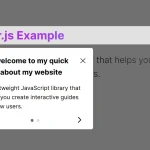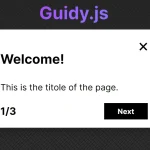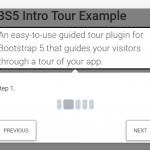| Author: | kamranahmedse |
|---|---|
| Views Total: | 4,395 views |
| Official Page: | Go to website |
| Last Update: | May 13, 2025 |
| License: | MIT |
Preview:

Description:
Driver.js is a lightweight yet powerful JavaScript library to create an animated, interactive, user-friendly visual guide for any web elements.
Features:
- With or without animations.
- With or without background overlay.
- Highlights web elements when the guide is active.
- Popover style step-by-step guide.
Basic usage:
1. Installation.
# Yarn $ yarn add driver.js # NPM $ npm install driver.js --save
2. Import the Driver.js.
<link rel="stylesheet" href="/path/to/dist/driver.min.css"> <script src="/path/to/dist/driver.min.js"></script>
// OR as an ES module
import { driver } from "driver.js";
import "driver.js/dist/driver.css";3. Create new Driver instance and we’re ready to go.
// required if using UMD mode const driver = window.driver.js.driver; // initialize driver.js const driverObj = driver();
4. Highlight a specific element within the document.
driverObj..highlight({
element: "#element",
popover: {
title: "Popover Title",
description: "Description"
}
});5. Create a step-by-step guided tour.
const driverObj = driver({
showProgress: true,
steps: [
{
element: '#element 1',
popover: {
title: 'Step 1',
description: 'Description 1',
side: "left",
align: 'start'
}},
{
element: '#element 2',
popover: {
title: 'Step 2',
description: 'Description 2',
side: "right",
align: 'start'
}},
// ...
]
});
// start the guide
driverObj.start();6. All possible options for the Driver.js.
const driverObj = driver({
// Array of steps to highlight. You should pass
// this when you want to setup a product tour.
steps?: DriveStep[];
// Whether to animate the product tour. (default: true)
animate?: boolean;
// Overlay color. (default: black)
// This is useful when you have a dark background
// and want to highlight elements with a light
// background color.
overlayColor?: string;
// Whether to smooth scroll to the highlighted element. (default: false)
smoothScroll?: boolean;
// Whether to allow closing the popover by clicking on the backdrop. (default: true)
allowClose?: boolean;
// Opacity of the backdrop. (default: 0.5)
overlayOpacity?: number;
// Distance between the highlighted element and the cutout. (default: 10)
stagePadding?: number;
// Radius of the cutout around the highlighted element. (default: 5)
stageRadius?: number;
// Whether to allow keyboard navigation. (default: true)
allowKeyboardControl?: boolean;
// Whether to disable interaction with the highlighted element. (default: false)
disableActiveInteraction?: boolean;
// If you want to add custom class to the popover
popoverClass?: string;
// Distance between the popover and the highlighted element. (default: 10)
popoverOffset?: number;
// Array of buttons to show in the popover. Defaults to ["next", "previous", "close"]
// for product tours and [] for single element highlighting.
showButtons?: AllowedButtons[];
// Array of buttons to disable. This is useful when you want to show some of the
// buttons, but disable some of them.
disableButtons?: AllowedButtons[];
// Whether to show the progress text in popover. (default: false)
showProgress?: boolean;
// Template for the progress text. You can use the following placeholders in the template:
// - {{current}}: The current step number
// - {{total}}: Total number of steps
progressText?: string;
// Text to show in the buttons. `doneBtnText`
// is used on the last step of a tour.
nextBtnText?: string;
prevBtnText?: string;
doneBtnText?: string;
// Called after the popover is rendered.
// PopoverDOM is an object with references to
// the popover DOM elements such as buttons
// title, descriptions, body, container etc.
onPopoverRender?: (popover: PopoverDOM, options: { config: Config; state: State }) => void;
// Hooks to run before and after highlighting
// each step. Each hook receives the following
// parameters:
// - element: The target DOM element of the step
// - step: The step object configured for the step
// - options.config: The current configuration options
// - options.state: The current state of the driver
onHighlightStarted?: (element?: Element, step: DriveStep, options: { config: Config; state: State }) => void;;
onHighlighted?: (element?: Element, step: DriveStep, options: { config: Config; state: State }) => void;;
onDeselected?: (element?: Element, step: DriveStep, options: { config: Config; state: State }) => void;;
// Hooks to run before and after the driver
// is destroyed. Each hook receives
// the following parameters:
// - element: Currently active element
// - step: The step object configured for the currently active
// - options.config: The current configuration options
// - options.state: The current state of the driver
onDestroyStarted?: (element?: Element, step: DriveStep, options: { config: Config; state: State }) => void;;
onDestroyed?: (element?: Element, step: DriveStep, options: { config: Config; state: State }) => void;;
// Hooks to run on button clicks. Each hook receives
// the following parameters:
// - element: The current DOM element of the step
// - step: The step object configured for the step
// - options.config: The current configuration options
// - options.state: The current state of the driver
onNextClick?: (element?: Element, step: DriveStep, options: { config: Config; state: State }) => void;;
onPrevClick?: (element?: Element, step: DriveStep, options: { config: Config; state: State }) => void;;
onCloseClick?: (element?: Element, step: DriveStep, options: { config: Config; state: State }) => void;;
});7. Available options for steps.
{
// The target element to highlight.
// This can be a DOM element, or a CSS selector.
// If this is a selector, the first matching
// element will be highlighted.
element: Element | string;
// The popover configuration for this step.
// Look at the Popover Configuration section
popover?: Popover;
// Callback when the current step is deselected,
// about to be highlighted or highlighted.
// Each callback receives the following parameters:
// - element: The current DOM element of the step
// - step: The step object configured for the step
// - options.config: The current configuration options
// - options.state: The current state of the driver
onDeselected?: (element?: Element, step: DriveStep, options: { config: Config; state: State }) => void;
onHighlightStarted?: (element?: Element, step: DriveStep, options: { config: Config; state: State }) => void;
onHighlighted?: (element?: Element, step: DriveStep, options: { config: Config; state: State }) => void;
}8. Available popover options.
{
// Title and descriptions shown in the popover.
// You can use HTML in these. Also, you can
// omit one of these to show only the other.
title?: string;
description?: string;
// The position and alignment of the popover
// relative to the target element.
side?: "top" | "right" | "bottom" | "left";
align?: "start" | "center" | "end";
// Array of buttons to show in the popover.
// When highlighting a single element, there
// are no buttons by default. When showing
// a tour, the default buttons are "next",
// "previous" and "close".
showButtons?: ("next" | "previous" | "close")[];
// An array of buttons to disable. This is
// useful when you want to show some of the
// buttons, but disable some of them.
disableButtons?: ("next" | "previous" | "close")[];
// Text to show in the buttons. `doneBtnText`
// is used on the last step of a tour.
nextBtnText?: string;
prevBtnText?: string;
doneBtnText?: string;
// Whether to show the progress text in popover.
showProgress?: boolean;
// Template for the progress text. You can use
// the following placeholders in the template:
// - {{current}}: The current step number
// - {{total}}: Total number of steps
// Defaults to following if `showProgress` is true:
// - "{{current}} of {{total}}"
progressText?: string;
// Custom class to add to the popover element.
// This can be used to style the popover.
popoverClass?: string;
// Hook to run after the popover is rendered.
// You can modify the popover element here.
// Parameter is an object with references to
// the popover DOM elements such as buttons
// title, descriptions, body, etc.
onPopoverRender?: (popover: PopoverDOM, options: { config: Config; state: State }) => void;
// Callbacks for button clicks. You can use
// these to add custom behavior to the buttons.
// Each callback receives the following parameters:
// - element: The current DOM element of the step
// - step: The step object configured for the step
// - options.config: The current configuration options
// - options.state: The current state of the driver
onNextClick?: (element?: Element, step: DriveStep, options: { config: Config; state: State }) => void
onPrevClick?: (element?: Element, step: DriveStep, options: { config: Config; state: State }) => void
onCloseClick?: (element?: Element, step: DriveStep, options: { config: Config; state: State }) => void
}9. API methods.
// Start the tour using `steps` given in the configuration
driverObj.drive(); // Starts at step 0
driverObj.drive(4); // Starts at step 4
driverObj.moveNext(); // Move to the next step
driverObj.movePrevious(); // Move to the previous step
driverObj.moveTo(4); // Move to the step 4
driverObj.hasNextStep(); // Is there a next step
driverObj.hasPreviousStep() // Is there a previous step
driverObj.isFirstStep(); // Is the current step the first step
driverObj.isLastStep(); // Is the current step the last step
driverObj.getActiveIndex(); // Gets the active step index
driverObj.getActiveStep(); // Gets the active step configuration
driverObj.getPreviousStep(); // Gets the previous step configuration
driverObj.getActiveElement(); // Gets the active HTML element
driverObj.getPreviousElement(); // Gets the previous HTML element
// Is the tour or highlight currently active
driverObj.isActive();
// Recalculate and redraw the highlight
driverObj.refresh();
// Look at the configuration section for configuration options
// https://driverjs.com/docs/configuration#driver-configuration
driverObj.getConfig();
driverObj.setConfig({ /* ... */ });
driverObj.setSteps([ /* ... */ ]); // Set the steps
// Look at the state section of configuration for format of the state
// https://driverjs.com/docs/configuration#state
driverObj.getState();
// Look at the DriveStep section of configuration for format of the step
// https://driverjs.com/docs/configuration/#drive-step-configuration
driverObj.highlight({ /* ... */ }); // Highlight an elementChangelog:
v1.3.6 (05/13/2025)
- Bugfixes
v1.3.4 (02/02/2025)
- Bugfixes
v1.3.1 (11/11/2023)
- Update
v1.3.0 (09/11/2023)
- Update vite configuration to support ES2019
- Popover title to support HTML
- Fixes wrong type definition for onPopoverRender configuration
- Add validation on class name
- Upgrade all the dependencies to latest
v1.2.0 (07/24/2023)
- Adds new disableActiveInteraction config to disable interaction with the active element.
- Bugfixes
v1.1.0 (07/24/2023)
- Implemented focus trapping
- Adds ARIA attributes and use of semantic markup.
v1.0.3 (07/07/2023)
- Rewritten in TypeScript.
- Popover is much more intelligent in its placement
- Supports async steps to allow more dynamic and interactive guides
- Support for non-element steps (i.e. where you just want to show a popup on screen)
- Ask for confirmation before exit
- Support for scrollable elements
- Allows showing progress during product tours
- More customizable than ever with more hooks
- Improved documentation with code samples for usage
- Popover hooks allow you to have more control over the popover rendering
v0.9.8 (03/21/2020)
- Resolve merge conflicts
v0.9.8 (02/29/2020)
- Adds step counter feature
v0.9.7 (06/15/2019)
- Updates Dependencies
v0.9.6 (06/01/2019)
- Fix touch issue
- Error when hiding on an element without popover
v0.9.3 (02/24/2019)
- Update
v0.9.2 (02/10/2019)
- Add more options
- Doc updated
v0.7.1 (10/12/2018)
- Add more options
- Optimize
v0.6.0 (06/30/2018)
- Add support for asynchronous actions
v0.5.2 (05/23/2018)
- Add keyboardControl option and typo in readme










